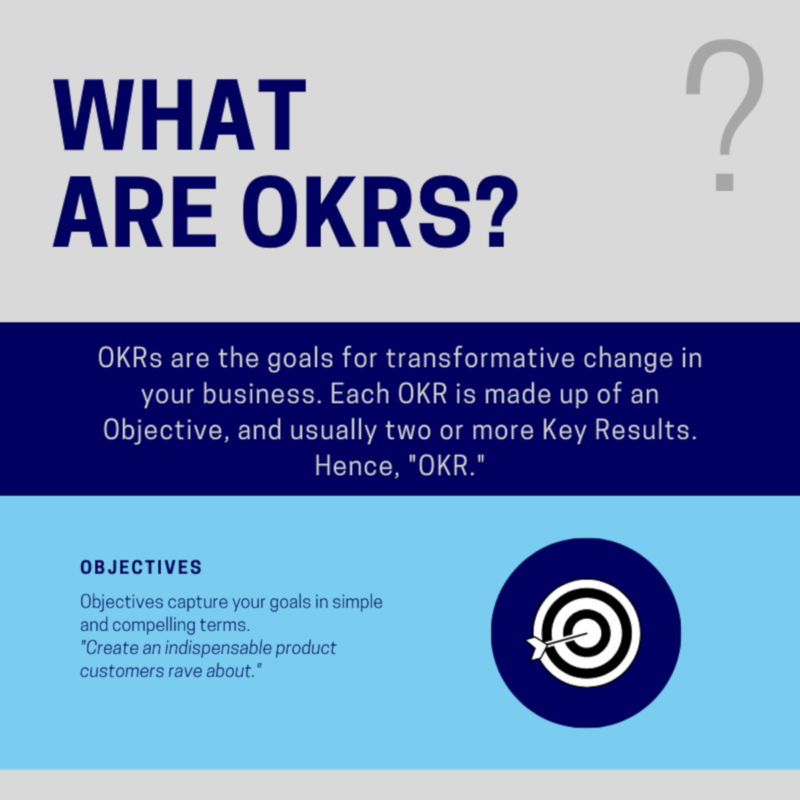Objectives and Key Results, or just OKRs, are an incredibly valuable strategic planning tool. Let’s dive in to learn more about what they are and how small-to-medium businesses can apply them for maximum impact.
What ARE OKRs Exactly?
There’s what they are, and there’s what they’re made of.
Regarding what they are, OKRs are the goals for transformative change in your business. Put differently, OKRs capture the change you want to make in your business.
To break down what OKRs are made of, Objectives and Key Results are made up of… wait for it… two parts, Objectives, and Key Results. (I know, right!?)
- Objectives capture your actual goals in simple and compelling terms.
 Objectives identify the specific transformative changes you want to make in your business. The job of an Objective is to make it super clear to everyone what direction we’re aiming toward. I dive deeper into this and give examples in the article Setting Objectives in OKRs.
Objectives identify the specific transformative changes you want to make in your business. The job of an Objective is to make it super clear to everyone what direction we’re aiming toward. I dive deeper into this and give examples in the article Setting Objectives in OKRs. - Key Results lay out the chunks of work that must be accomplished in order for the Objective to be met.
 Again, in the article Setting Key Results in OKRs I deep dive, but the idea is that Key Results provide the top level outline of the work that must be accomplished. When every Key Result is accomplished, the Objective has been accomplished, too.
Again, in the article Setting Key Results in OKRs I deep dive, but the idea is that Key Results provide the top level outline of the work that must be accomplished. When every Key Result is accomplished, the Objective has been accomplished, too.
And that’s why OKRs are so powerful – because of the role they play in the business.
What Role do OKRs Play?

OKRs are the bridge between vision and action. They provide the glue of strategy. Think about that for a moment and let’s unpack it a bit.
It’s relatively easy to figure out what you want to change about your business. And with a little effort, it’s usually doable to turn that into a clear picture – a vision of the future. But when it’s time for the rubber to meet the road, there are usually at least two problems that rear their heads.
- Daily work of the business gets in the way and it’s hard to focus on change.
- A vision of the future isn’t the same thing as an action plan of how to make it happen.
OKRs solve that by bridging the gap. Through Key Results, OKRs don’t necessarily identify every Action Step, but they identify enough to make the work tangible and real. And in accomplishing that, they create work that can be scheduled into and reviewed as part of the daily work.
So OKRs are 100% a strategy tool in that they help set the direction of transformative change as well as determine how to make the change happen. But in being a strategy tool, they also bridge the gap between vision and action, making it much easier to accomplish big goals.
![]()
Download Your FREE OKR Workbook
Get a pre-made Excel template featuring examples, explanations, and built-in calculations.
How Do We Use OKRs?
As you may have guessed, the next few articles are going to walk you through some techniques for how to establish OKRs. But the question becomes once we’ve got OKRs established, how do we use them?
Pay special attention to the following two articles as they spell out how to make maximum use of OKRs:
- Setting Key Results in OKRs
 As you’ll see, Key Results establish the categories of work that need to be done. It’s these categories of work where all the action is and therefore where a lot of the power of OKRs resides.
As you’ll see, Key Results establish the categories of work that need to be done. It’s these categories of work where all the action is and therefore where a lot of the power of OKRs resides. - OKR Review Process
 Once you’ve got OKRs set up, committing to a cadence of review gives them life, energy, and the power to transform your business for the better. The rituals of review I talk about here are a critical piece in that puzzle.
Once you’ve got OKRs set up, committing to a cadence of review gives them life, energy, and the power to transform your business for the better. The rituals of review I talk about here are a critical piece in that puzzle.
Bringing it Together
With this article, you should have a beginning of a picture of how OKRs can integrate with and transform your work and your business. The other articles in this series will help bring this to life. And when you’re ready, check out my series on KPIs to really bring things alive.
Back to Index | OKRs as Strategy and Alignment


